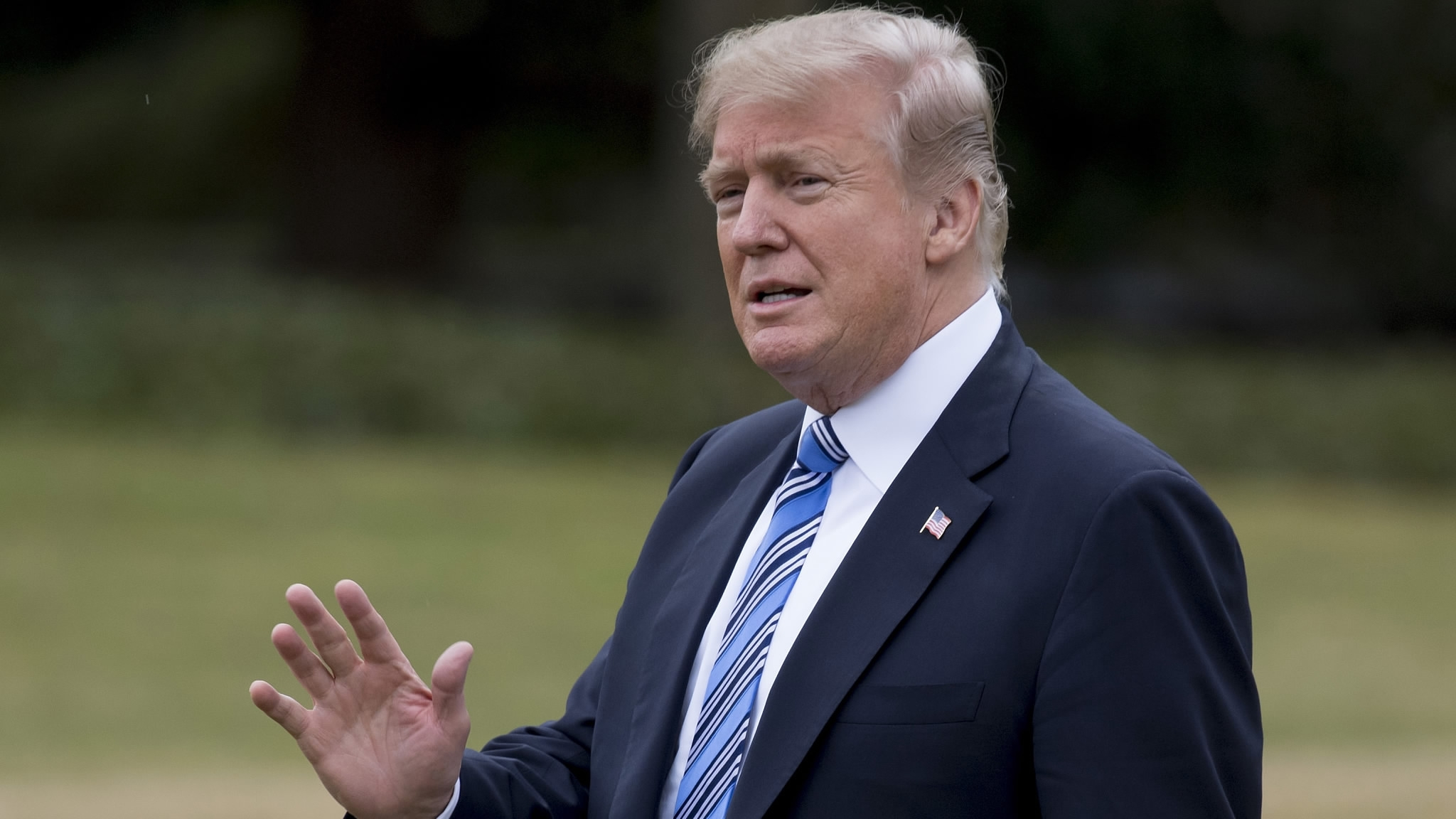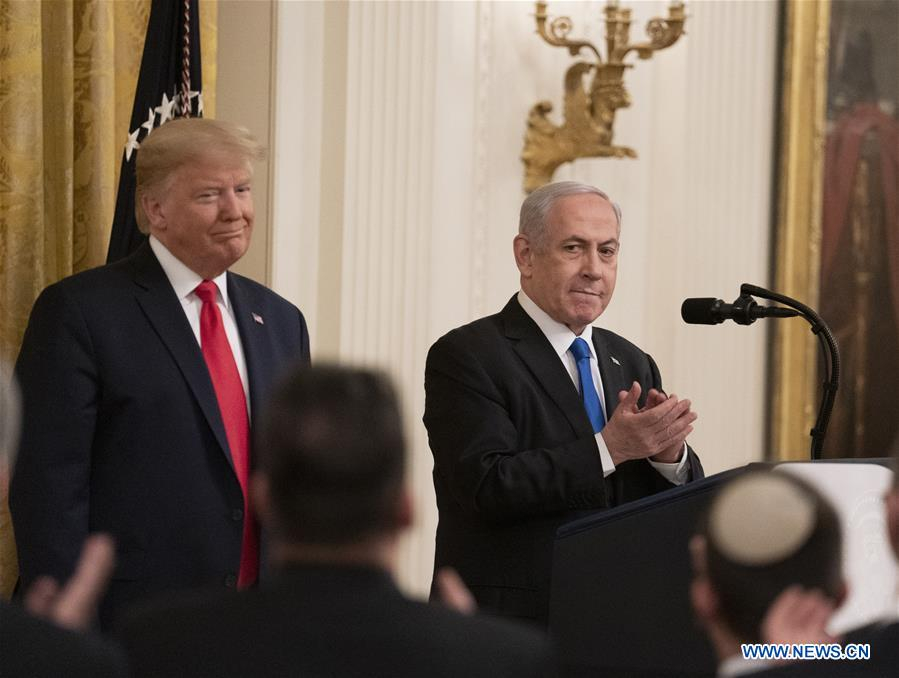
U.S. President Donald Trump.
U.S. President Donald Trump.
Editor's note: Hannan Hussain is a security analyst at the London School of Economics - South Asia Center, and an author. The article reflects the author's opinions, not necessarily the views of CGTN.
Washington's stance on promoting Israeli interests at the expense of Palestine's territorial sovereignty has come full circle. On January 28, President Trump revealed his long-sought Middle East Peace Plan, a 181-page "solution" to the 100-year long Israeli-Palestinian conflict, now served with a "two-state" remedy.
The move, in truth, aims to establish Israel's sovereignty over illegal West Bank settlements, render Jerusalem as its "undivided capital", and give Palestinians the illusion of an "independent state" – based on a 50 billion U.S. dollars economic revival plan announced last June.
The strategy, billed as a "win-win solution" by Mr. Trump, carries nothing but the unilateral will of Washington, and threatens to permanently eclipse Palestinians' quest for statehood.
Legitimacy of the peace-plan in question
It is important to note that the peace plan arrives without the will of the Palestinians on-board. Leaders from the region have refused to meet the Trump administration for over two years straight – and the current roadmap is certainly not an effort to inquire about the actions leading up to this discord.
Not a single attempt took place from the Trump administration to engage Palestine through a democratic referendum or, at the least, proportionate representation. Instead, the Middle East Peace Plan serves as a "take-it-or-leave-it" ultimatum devoid of indigenous ownership and legitimacy – a fundamental requirement for any lasting peace exercise in the Middle East.
Mr. Jared Kushner, Trump's son-in-law, one of the chief architects of the plan, also called upon Palestinian leaders to "stop posturing" and accept the plan – a confirmation of Trump's pledge to "recognize Israeli sovereignty over the territory", and align Washington's vision with "part of the state of Israel."
This marks a massive reversal in Washington's earlier rationale, which vouched for Israel's self-defense needs in a tough neighborhood. Instead, the so-called "historic opportunity" is a predetermined policy imperative, aimed at using Palestinian sovereignty to engineer a re-alignment in the Middle East: the Gulf's perception of the Israeli state.
Asymmetrical leverage with Israel
The Palestinian state's map structure, according to data with the White House, is squeezed between the larger boundaries of Israeli settlements. Nearly fifteen Israeli enclaves are set to pepper across the West Bank map, allowing Israel to maintain de-facto control over any "sovereign status" that the U.S. attaches to the new Palestinian state.
More tellingly, the plan puts Tel Aviv under no compulsion to relinquish any of its West Bank settlements that have been a cause of contention for over five decades. Instead, cropping up a new Palestinian entity on the periphery of these settlements helps mainstream Israeli occupations as legitimate.
Moreover, it paves the way for exporting the "two-nation" phenomenon as a neutral arrangement, spearheaded by Washington – a third-party.
Collectively, this asymmetrical leverage allows Israel to promote its process of annexation as a democratic exercise as well. One crucial evidence from the so-called Middle East Peace Plan is Israel's decision to limit its settlement construction in a four-year "land freeze."

U.S. President Donald Trump (L) and Israeli Prime Minister Benjamin Netanyahu attend a joint press conference in the White House in Washington D.C., the United States, January 28, 2020. /Xinhua Photo
U.S. President Donald Trump (L) and Israeli Prime Minister Benjamin Netanyahu attend a joint press conference in the White House in Washington D.C., the United States, January 28, 2020. /Xinhua Photo
According to the plan, this four-year pause is a moment to usher-in "dialogue" with Palestinian leaders – but the desire for talks after the controversial announcement ensures all Palestinian demands will be deprived of due autonomy.
Similarly, Mr. Netanyahu's decision to effectively annex one-third of the West Bank settlements through the cabinet's approval is a move to portray Trump's peace prerogative as Israel's own democratic initiative. If successfully executed, the move would shake the core pillars of Palestine's "statehood."
These pillars include a standing military presence, right-based resistance to any forthcoming Israeli aggression, and Palestine's national identity – which distinguishes itself from the Israeli brand of regional peace.
Total eclipse of Palestinian sovereignty
There are several repercussions of pursuing the Middle East Peace Plan in the absence of Palestinian will – each of which could drive the existing territorial conflict to the next level.
First, the proposed boundaries in the 181-page document are not in accordance with the UN-approved, pre-1967 armistice lines. These lines ensured a degree of protection against any eventuality, where the threat of forced occupation – whether from the Israeli or Palestinian side – becomes imminent upon a given population.
Of course, to effect an arrangement in accordance with the criteria, would first require Tel-Aviv to backtrack its core interest: invite international scrutiny on Israeli military occupation, on both ends of the armistice lines.
Second, the peace plan brutally underestimates Palestine's needs for an independent recognition, one which is agreed upon by the people of Palestine and falls within the realm of self-defense.
Instead, the Trump administration envisions a "two-capital" distribution of Jerusalem – one for Israel, and the Eastern belt for Palestine. The offer hides a fundamental fact: the Eastern half of Jerusalem has been long-abandoned by Israel, fortified with a security barrier, and treated as a leftover territory.
Third, future attempts by Palestine to resist the annexation design will probably be viewed by Washington, Tel Aviv, and its allies as "an act of aggression". "After 70 years of little progress, this could be the last opportunity they will ever have", said Mr. Trump during the peace plan announcement.
The message here is clear: Palestine's "independent state" is now a reality, even if it arrives at the fringes of Israel's territorial expansion.
Ultimately, as both Trump and Netanyahu look to turn a historic dispute into Israel's favor, and deflect domestic opposition – Washington is almost certain to see this plan to the end. But to place Israel's territorial hegemony at the center of a "Middle East" peace strategy, U.S. risks promoting permanent escalations that no amount of dialogue could ever counteract.
(If you want to contribute and have specific expertise, please contact us at opinions@cgtn.com.)